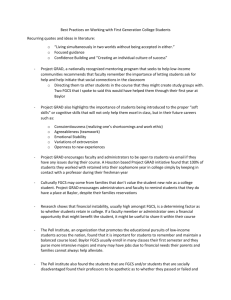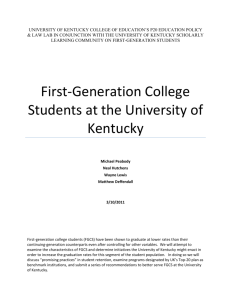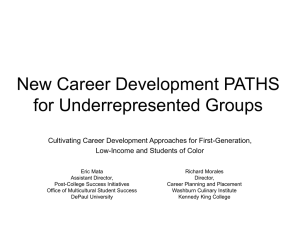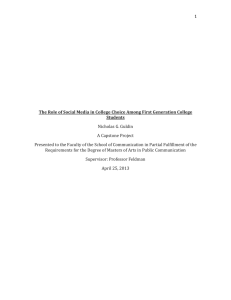First Generation White Paper, March 2011
advertisement
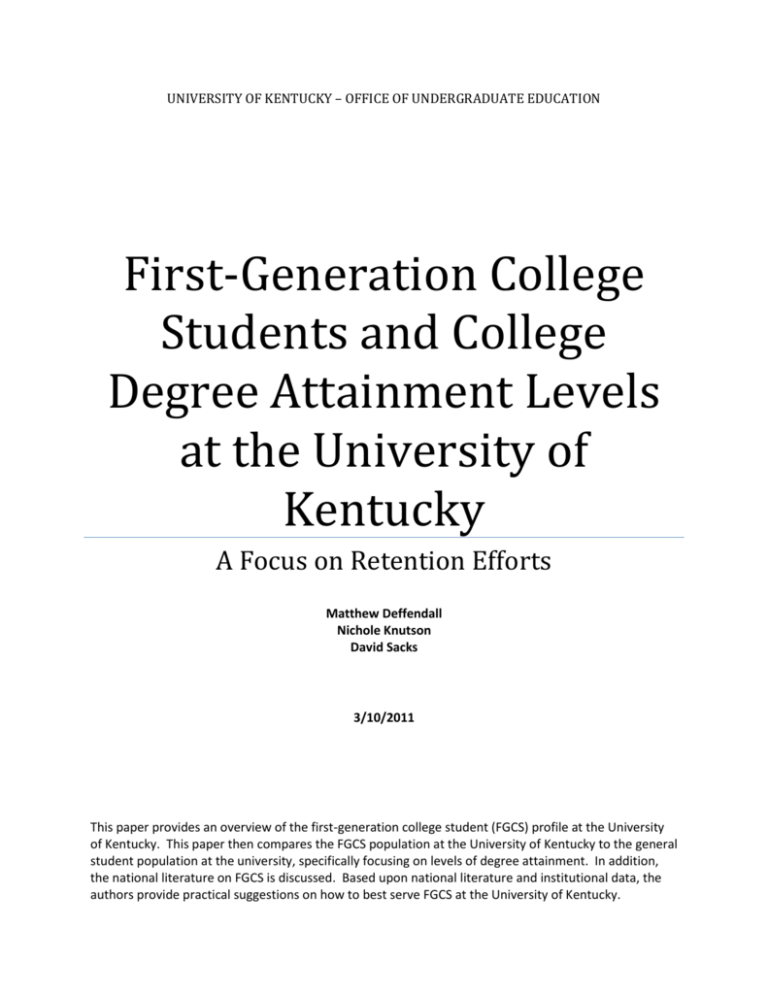
UNIVERSITY OF KENTUCKY – OFFICE OF UNDERGRADUATE EDUCATION First-Generation College Students and College Degree Attainment Levels at the University of Kentucky A Focus on Retention Efforts Matthew Deffendall Nichole Knutson David Sacks 3/10/2011 This paper provides an overview of the first-generation college student (FGCS) profile at the University of Kentucky. This paper then compares the FGCS population at the University of Kentucky to the general student population at the university, specifically focusing on levels of degree attainment. In addition, the national literature on FGCS is discussed. Based upon national literature and institutional data, the authors provide practical suggestions on how to best serve FGCS at the University of Kentucky. INTRODUCTION In 2007, Provost Subbaswamy declared a “War on Attrition” at the University of Kentucky. Since 2007, the University has implemented strategies and initiatives geared towards increasing undergraduate student retention and graduation rates. In an effort to increase graduation rates, the University targeted specific high-risk student populations including historically underrepresented groups in higher education and/or students who exhibit academic deficiencies. High-risk refers to the likelihood that a student will leave the university without earning a degree. First-generation college students (FGCS) are considered high-risk as these students are less likely to graduate from college as compared to their peers who have at least one parent with a college education (National Center for Educational Statistics, 2005). This paper first identifies the profile of FGCS at the University of Kentucky (UK) and then examines national literature on FGCS. Within the literature, the definition of a first-generation student varies. For the purpose of this paper, a first-generation college student is defined as a student whose parents never completed a four-year college degree. If one of the student’s parents has a college degree, then they are not considered first-generation. A continuing or non-first-generation college student refers to a student who has at least one parent possessing a four-year college degree. Using the UK FGCS profile, this paper then compares the UK FGCS population to the overall freshmen profile at the University of Kentucky, specifically focusing on levels of degree attainment. The UK data utilized in this paper is drawn from self-reported student records, including student surveys and applications for admittance to the university. This paper is intended to provide an overview of students enrolled at the University of Kentucky 1 who self-identify as being a first-generation student and also to provide practical suggestions on how to best serve FGCS at the university. 2009 FRESHMEN CLASS PROFILE AT THE UNIVERSITY OF KENTUCKY GENDER The full-time freshmen class enrolled at the University of Kentucky in the fall of 2009 included a total of 4,111 students. Table 1 represents the number of full-time, first-generation freshmen in the fall 2009 cohort disaggregated by gender. According to the University’s Office of Institutional Research over 17% of the students in this cohort self-identified as being a firstgeneration student. Of the FGCS in the fall 2009 cohort, the female population was slightly higher with 9.3% of all FGCS identifying as female and 8.1% of the total FGCS identifying as male. This also held true for the non-FGCS population as 41.9% of the students identified as female and 40.6% of the non-FGCS population identifying as male. Table 1 Gender of fall 2009 first-time, full-time degree seeking students (cohort 2009) Non-FGCS Gender FGCS n %* n %* Total Female 1722 41.9 383 9.3 2105 Male 1671 40.6 335 8.1 2006 Total 3393 82.5 718 17.4 4111 * The percentage reflect total population of 4111 2 ETHNICITY Of the 718 first–year students who identified as first-generation, the largest ethnic category was White, with more than 73.54% of FGCS identifying as a White student. The next highest self-identified ethnic group of FGCS was African-American, with over 17.55% of students self-identifying as African-American. 3.34% of the FGCS identified as being Asian and 2.79% of the students identified themselves as Hispanic. The least represented response options were American Indian and Nonresident Alien, both at 0.14% of the total FGCS population for the 2009 cohort. 76 or 2.51% of the students who identified as first-generation chose not to identify their ethnicity. Table 2 represents the number of first-generation full-time freshman in the fall of 2009 disaggregated by ethnicity. Table 2 Ethnicity of fall 2009 full-time freshmen at the University of Kentucky Non-FGCS Ethnicity FGCS Total Ethnicity by FGCS % n %* n %* Nonresident Alien 43 1.0 1 0.0 44 0.14 African American 273 6.6 126 3.1 399 17.55 American Indian 10 0.2 1 0.0 11 0.14 Asian 72 1.8 24 0.6 96 3.34 Hispanic 57 1.4 20 0.5 77 2.79 2880 70.1 528 12.8 3408 73.54 58 1.4 18 0.4 76 2.51 3393 82.5 718 17.4 4111 100 White Missing/Left Blank Total * The percentage reflect total population of 4111 3 GPA and ACT SCORES At the University of Kentucky from 2006 -2010, high school GPA, ACT scores and firstyear college GPAs are lower across the board for FGCS. The range of mean high school GPAs for the non-FGCS, 2006-2010 cohorts ranged from 3.53-3.62 while the mean high school GPAs for the FGCS ranged from 3.43-3.55. When comparing ACT scores for the 2006-2010 cohorts, the non-FGCS scored higher each year than did their first-generation peers. ACT scores ranged from 23.13-24.25 for FGCS and from 24.20-25.49 for non-FGCS. At the completion of the fall semester, FGCS fall short of their peers each year when it comes to college GPA. From 2006-2010, FGCS earn first semester GPAs ranging from 2.4-2.6 while their non-first-generation peers outperform them, earning GPAs ranging from 2.7-3.0. At the end of the first year at the university, FGCS continue to be outperformed year after year as compared to their peers. The year-end GPAs for FGCS range from 2.4-2.6 and from 2.6-2.8 for non-FGCS. 4 Table 3 Comparison high school GPA, ACT scores, first fall at UK GPA, and first year at UK GPA of self-identified FGCS and all non-FGCS incoming freshmen students at UK High School GPA Mean Cohort 2006 2007 2008 2009 2010 ACT scores First Fall at UK GPA Mean Mean First Year at UK GPA Mean Non-FGCS 3.48 24.20 2.7 2.6 FGCS 3.46 23.13 2.4 2.4 Non-FGCS 3.49 24.52 2.8 2.8 FGCS 3.43 23.26 2.5 2.5 Non-FGCS 3.52 24.59 2.8 2.8 FGCS 3.50 23.49 2.6 2.6 Non-FGCS 3.53 24.91 2.9 2.8 FGCS 3.47 23.62 2.6 2.6 Non-FGCS 3.62 25.49 3.0 FGCS 3.55 24.25 2.6 PRIMARY COLLEGE AT POINT OF ADMISSION The following table represents the university breakdown by college of initial enrollment for the 2009 cohort. The college with the largest number of first-generation students enrolled at the point of admission was Undergraduate Studies with Arts & Sciences being the second most common college of enrollment. This finding was comparable for non-FGCS as they were also most likely to initially enroll in Undergraduate Studies and Arts & Sciences. Regardless of their generational status, students were the least likely to enroll in the College of Social Work at the point of admission. 5 Table 4 Primary college at point of enrollment for fall 2009 freshmen at UK College Non-FGCS FGCS Total n %* n %* Agriculture 227 5.5 56 1.4 283 Health Sciences 25 0.6 6 0.1 31 Arts & Sciences 771 18.8 180 4.4 951 Business & Economics 457 11.1 71 1.7 528 Communications & Information Studies 114 2.7 16 0.4 130 Design 57 1.4 7 0.2 64 Education 199 4.8 36 0.9 235 Engineering 457 11.1 90 2.2 547 Fine Arts 102 2.5 17 0.4 119 Nursing 197 4.8 31 0.8 228 Social Work 13 0.3 3 0.1 16 Undergraduate Studies 774 18.8 205 5.0 979 Total 3393 82.4 718 17.6 4111 RETENTION AND GRADUATION RATES The University of Kentucky’s application for admission started providing students with an opportunity to identify as being a first-generation student in 2006. Retention and graduation data collected at UK since 2006 demonstrates that FGCS are retained at significantly lower rates than their non-first-generation peers. According to the Office of Institutional Research at UK, the first fall to third fall retention rate for the 2006 cohort was 59% for FGCS and 70.35% for non-FGCS, a difference of approximately 11%. The four-year degree completion 6 rate for the 2006 cohort was 20.5% for FGCS and 29.15% for non-FGCS, an overall difference of 9%. The retention rates of FGCS begin to lag behind their peers as early as their first semester at the university. Since UK began tracking FGCS in 2006, this population has been retained at rates lower than their continuing-generation peers for each cohort and for every single semester. In 2006, as FGCS continued to be monitored at the university, the largest discrepancy in retention rates came between the first fall to third fall semesters, resulting in a disparity of over 11% between FGCS and their peers. Despite the fact that the university does not yet have six-year degree completion rates for any cohorts, preliminary retention rates from 2007-2010 indicate that the disproportion of retention rates from semester to semester intensify. Table 5 Comparison of retention and graduation rates of self-identified FGCS and all non-FGCS incoming freshmen students at UK First Fall Enrollment Cohort 2006 2007 2008 2009 2010 N First Fall to First Spring Retention n % First Fall to Second Fall Retention n % First Fall to Third Fall Retention n % Four Year Degree Completion n % Non-FGCS 3396 3073 90.49 2650 78.03 2389 70.35 990 29.15 FGCS 722 613 84.90 495 68.56 426 59.00 148 20.50 Non-FGCS 3210 2964 92.34 2642 82.31 2357 7343 FGCS 625 544 87.04 462 73.92 371 59.36 Non-FGCS 3374 3136 92.95 2751 81.54 2449 72.58 FGCS 705 629 89.22 524 74.33 448 63.55 Non-FGCS 3393 3214 94.72 2829 83.38 FGCS 718 672 93.59 532 7409 Non-FGCS 3305 FGCS 977 7 NATIONAL LITERATURE ON FGCS Disparities between graduation rates based upon first-generation and continuinggeneration status are found at national levels. In 2005, the National Center for Educational Statistics and the U.S. Department of Education reported that 24% of first-generation students nationally who enroll in postsecondary education earn a Bachelor’s degree as opposed to 68% of students whose parents were college graduates (Chen & Carroll, 2005). Within the same study, a transcript analysis of over 7,000 undergraduate students revealed that first-generation students complete fewer credit hours in the first year of college. This cumulative pattern in course enrollment delays graduation and is strongly associated with the likelihood that a student will leave the university without earning a degree (Chen & Carroll, 2005). Research on first-generation students supports the theory that this student population encounters greater challenges than their non-first-generation counterparts (Engle, Bermeo, & O’Brien, 2006; Oldfield, 2007). Since these students are the first in their families to go to college, their parents are unlikely to be familiar with the college process and the terminology that accompanies higher education, all of which are taught skills. Devoid of this terminology and a post-secondary navigational map, these students often find themselves struggling in the transition from high school to college. Collier and Morgan (2008) defined the transitional challenges from high school to college for first-generation students as a lack of understanding the “college student role.” One struggle that has been identified is the “imposter phenomenon” (Davis, 2010). The “imposter phenomenon” suggests that FGCS feel like a fraud as a college student. This often leads FGCS to refrain from class participation, perceiving that 8 the “real” students who belong in college have nothing to gain from hearing from the FGCS (Davis, 2010). Lacking an awareness of the college experience, parents of FGCS have difficulty understanding why their students need to study more in college than they did in high school and also, why it is beneficial for students to spend time engaging in the campus community. Parents who have experienced the college process possess the skills and abilities to guide their student through the necessary steps and serve as an invaluable advantage for continuinggeneration college students to adjust to the “college student role.” Parents of FGCS put pressure on students to return home often and to assist with family chores, attend family events, look after younger siblings, elderly family members, and even contribute to household finances. Since FGCS are the first in their families to achieve a college degree, they tend to come from homes with limited financial resources (Engle & O’Brien, 2006). A lack of family support can affect a student’s likelihood to stay in college and to complete their degree (Ramos-Sanchez & Nichols, 2007). Simply being a first-generation student heightens the likelihood of leaving college without a degree, especially during their second year of college (McMurray, 2009). This is due to the amount of risk factors first-generation students often encounter from their families and often, their socio-economic status. Research indicates that first-generation students work more hours off campus, complete fewer credit hours in the first year of college and receive less support from family and friends than their continuing-generation peers (Terenzini et al, 1996; Pascarella et al, 2004). When students work off campus more than 20 hours a week they have less opportunity to build a connection to campus through meeting peers, involvement in student 9 organizations, attending tutoring sessions, meeting with professors during office hours and as a result, struggle to complete 15 credit hours per semester. In addition, the lack of support from family and non-college going friends pulls these students away from campus and decreases their motivation and confidence towards completing a college degree. McGregor et al (1991) and Corcoran (1995) found that traditional college students had higher self-esteem scores than did comparative first-generation students. One explanation for this finding is that parents from low socio-economic status backgrounds may not promote self-confidence in their children at the same levels as students whose parents have college degrees. Lucas (2001) supports this theory as well, claiming that coming from a family with a low socio-economic status background is directly related to a student’s level of educational attainment. Another prevalent challenge for FGCS is feeling academically under prepared for college (Ramos-Sanchez & Nichols, 2007). FGCS report feeling academically inferior to their peers and to having less developed study skills as evidenced in pre-college differences between these two types of students (Chen, 2005; Cushman, 2007; Ishitani, 2006). These factors may lead to decreased academic motivation, lower self-confidence levels and ultimately, dropping out of college. First-generation students self-report that they do not feel prepared academically for the shift from high school classes to college classes. High school students must transition from spending less than five hours a week studying and 30 hours in class to 15-18 hours a week in class and a recommended 30 hours a week studying. This transition affects all students but is especially difficult for FGCS who lack the family support and knowledge of how to be successful in a college environment. 10 Based on national data, we are able to conclude that being a FGCS places students into a high risk category (National Center for Educational Statistics, 2005). To address the challenges commonly experienced by FGCS, retention strategies are critical early in the students’ college careers, before the students either choose to drop out of college voluntarily or are forced to leave as a result of poor academic performance. One early intervention that has been beneficial for FGCS at the University of Kentucky is enrollment in a first-year seminar (UK 101). As illustrated in the graph below, which includes the 2006-2009 cohorts; FGCS at the University of Kentucky are less likely to be retained in their first year at the university than are their continuing-generation peers. This graph demonstrates that with the addition of an early intervention retention strategy, in this case UK 101, both FGCS and continuing-generation students show an increase in first year retention; however, the FGCS show a greater gain in retention. With the addition of UK 101, FGCS first year retention rates increase from 70.9% to 74.3%, a gain of 3.4%. While non-FGCS also experience a gain in retention rates, the percentage increase is from 79.9% to 82.7%, a slightly lower gain of 2.8%. As the graph below indicates, it is vital for postsecondary institutions to target FGCS with proactive and early interventions so that these students have the resources and support systems in place to guide them from their first semester on campus to the successful completion of their undergraduate degree. 11 Graph 1: First-Generation Status and Enrollment in UK 101 Retention for all Cohorts 2006-2009 Research indicates that support programming, such as UK 101, that aid the transition to college for first-generation students increase retention and degree attainment levels (Jenkins et al, 2009; Davis, 2010). These opportunities offer FGCS the opportunity to make personalized connections with the university. Individual attention can be in the form of positive role-models through faculty, staff, additional advisors, and through peer mentoring. Peer resources are more significant to student success than family resources (Dennis et al, 2005). As it is common for FGCS to experience pressure from their family members to often return home, it’s beneficial for the students to have a peer support network on campus. Students benefit from experiences with a mentor who is like them; which is why FGCS reap the most benefits from mentors who are also FGCS (Davis, 2010). In addition, to peer mentors Gullat and Yan (2003) 12 identified a key component of a successful program for FGCS to include the presence of adult role models. In an attempt to target, recruit and graduate first-generation students from colleges and universities, national programs such as Student Support Services, Upward Bound, Talent Search and Gear Up were developed to provide specific services to first-generation students in hopes that these programs would increase the college going rate as well as degree attainment rates. Aside from national programs aimed at serving FGCS, states and individual institutions have created programs and scholarships to assist these students throughout the college going process. FGCS face unique challenges and need additional support and interventions to ensure they are retained and graduate at similar rates to their continuing-generation peers. To support FGCS, the University of Kentucky has developed several programs. FIRST-GENERATION PROGRAMMING AT THE UNIVERSITY OF KENTUCKY The Robinson Scholars Program (RSP) is one such program at the University of Kentucky, which selects incoming high school students from low-achieving counties in eastern Kentucky. Twenty-nine are selected annually for the Robinson Scholarship. RSP students are able to enroll at UK or a community college as incoming freshman. These students receive support services through a secondary advisor, peer advisor, and a scholarship covering the cost of tuition, fees, room and board. In operation since 1996, the program has named 510 students as Robinson Scholars. 13 Student Support Services (SSS), a federally funded TRIO1 program, supports students who are first-generation, low-income, and/or have a documented disability, transition to college life at UK. Due to grant limitations, services are restricted to 166 students per year with an average of 25-30 new freshmen added each year. Students receive secondary advising, peer mentoring, participate in peer tutoring, student success workshops, and assisting in applying to graduate or professional school. Appalachian and Minority students in Science, Technology, Engineering, and Mathematics Majors (AMSTEMM) is a National Science Foundation (NSF) grant funded program providing a community environment, a network of support services and numerous academic enhancement opportunities to current undergraduate students in science, technology, engineering, and mathematics (STEM) majors at UK (which are Agricultural Biotechnology, Biology, Chemistry, Engineering (all majors), Geology, Mathematics, Physics, Mathematics Education and Science Education). Program participants have a secondary advisor devoted to AMSTEMM students, peer mentoring, special sections of math and science courses, access to faculty-mentored research experiences, research fellowships during the semester or summer and study groups. Beginning in the fall of 2010 funded by a grant from The Suder Foundation, the First Scholars Program provides a holistic approach to twenty incoming freshmen who were Kentucky residents based on demonstrated academic ability in high school, financial need, and likelihood of success based on their performance on the Student Strengths Inventory. The mission of the program is to increase the graduation rates of first-generation students by 1 The Federal TRIO Programs (TRIO) are Federal funded outreach and student services programs designed to identify and provide services for individuals from disadvantaged backgrounds. TRIO includes eight programs targeted to serve and assist low-income individuals, first-generation college students, and individuals with disabilities to progress through the academic pipeline from middle school to post baccalaureate programs. 14 providing scholarship funds, a full-time scholarship advisor, a peer mentor, study groups, service projects and are required to live on campus during the first year. The $5,000 scholarships can be renewed annually for up to four years. In addition to these formal programs, UK provides scholarship and support services to students, who may be first-generation, through the William C. Parker Scholarship Program administered by the Center for Academic Resources and Enrichment Services (CARES). In fall 2009, 80 FGCS received the William C. Parker Scholarship and 150 FGCS participated in CARES. These programs help students to understand that academic success is not attained through individual achievement alone, but through a support network of peers, faculty, and advisors (Gullet & Jan, 2003). Less than 500 first-generation students are currently being offered specific first-generation services at the University of Kentucky. All students who are firstgeneration should be offered additional resources to assist with their acclimation to UK in order to improve their retention. 15 RECOMMENDATIONS The University of Kentucky should adopt a comprehensive program to support all FGCS. FGCS should be offered support services, such as assistance with time management in order to be academically successful in college. Encourage first-generation students to enroll in UK 101. First-generation students should have an additional advisor available to them who is trained to support the needs of FGCS. This ensures that FGCS will receive personalized attention and proactive interventions. The University should create a database of FGCS faculty and staff and catalog their stories online. This database will serve as a resource for FGCS to make personal connections at the university. Peer mentoring should be available to FGCS students. Colleges at the university with the highest initial enrollment of FGCS are encouraged to explore avenues for providing proactive services geared towards retaining FGCS. The University needs to continue to research first-generation students in order to offer successful interventions for first-generation students. 16 REFERENCES Ayala, C., & Striplen, A. (2002). A career introduction model for first-generation college freshmen students. Thriving in Challenging and Uncertain Times. Eric Digest. CG031994. Carter, C.S. & Robinson, R. (2002). Can we send some of the money back home to our families? Tensions of transition in an early intervention program for rural Appalachian students. Paper presented at the Annual meeting of the American Educational Research Association. Chen, X., & Carroll, D. (2005). First-generation students in postsecondary education. A look at their college transcripts. Washington, DC: US Department of Education, National Center for Educational Statistics. Collier, P. J., & Morgan, D. L. (2008). “Is that paper really due today?” Differences in firstgeneration and traditional college students’ understandings of faculty expectations. Higher Education: The International Journal of Higher Education and Educational Planning. 55(4), 425-446. Corcoran, M. (1995). Rags to rags: poverty and mobility in the united states. Annual Review of Sociology. 21, 237-267. Cushman, K. (2007). Facing the culture. Educational Leadership, 64 (7), 44-47. Davis, J. (2010). The First-generation Student Experience: Implications for Campus Practice, and Strategies for Improving Persistence and Success. Sterling, VA: Stylus Publishing. Dennis, J. M., Phinney, J. S., and Chuateco, L. I. (2005). The role of motivation, parental support, and peer Sspport in the academic success of ethnic minority girst-generation college students. Journal of College Student Development. 46 (3), 223-236. 17 Engle, J., & O’Brien, C. (2006). Straight from the source. What works with first-generation college students? The Pell Institute for the Study of Higher Education. First-generation Stories. California State University, http://firstgeneration.csufresno.edu/ Gullatt, Y. & Jan, W. (2003). How do pre-collegiate academic outreach programs impact collegegoing among underrepresented students? Washington, DC: Pathways to College Network Clearinghouse. Ishitani, T. T. (2006). Studying attrition and degree completion behavior among first-generation college students in the United States. Journal of Higher Education, 77(5), 861-885. Jenkins, A. L., Miyazaki, Y., & Janosik, S. M. (2009). Predictors that distinguish first-generation college students from non-nirst-generation college students. Journal of Multicultural, Gender and Minority Studies. 3 (1), 1-9. Kuh, G. D., Kinzie, J., Schuh, J. H., Whitt, E. J., & Associates (2005). Student success in college: creating conditions that matter. San Franscico: Jossey-Bass. Lucas, S. R. (2001) Effectively maintained inequality: education transitions, track mobility, and social background effects. American Journal of Sociology. 106 (6), 1642-90. McGregor, L. N., Mayleben, M.A., Buzzanga, V.L., Davis, S. F., & Becker, A. H. (1991). Selected personality characteristics of first-generation college students. College Student Journal, 25, 231-234. McMurray, A. J. and Sorrells, D. (2009). Bridging the gap: reaching first-generation students in the classroom. Journal of Instructional Psychology. 36 (3), 210-14. National Center for Education Statistics. (2005). First-generation students in postsecondary education: a look at their college transcripts. NCES 2005–17. 18 Nunez, A., & Cuccaro-Alamin, S. (1998). First-generation students: undergraduates whose parents never enrolled in postsecondary education (NCES 98-082). Washington, DC: U.S. Department of Education, National Center for Education Statistics Oldfield, K. (2007). Humble and hopeful: welcoming first-generation poor and working-class students to college. About Campus, January-February. Pascarella, E. T., Pierson, C. T., Wolniak, G. C., and Terenzeni, P. T. (2004). First-Generation College Students: Additional Evidence on College Experiences and Outcomes. Journal of Higher Education. 75 (3), 249-284. Ramos-Sanchez, L. & Nichols, L. (2007). Self-efficacy of first-generation and non-first-generation college students: the relationship with academic performance and college adjustment. Journal of College Counseling. 10 (1), 6-18. Smith, J. (2007). Effects of self-efficacy and self-esteem on homesickness and college adjustment. Paper presented at the Western Psychological Association Annual Convention, 2007. Terenzini, P. et al., (1996). First-generation college students: characteristics, experiences, and cognitive development. Research in Higher Education, 37, 1-22. Thayer, P. B. (2000). Retention of students from first-generation and low income backgrounds. Opportunity Outlook. (May), 2-8. 19
